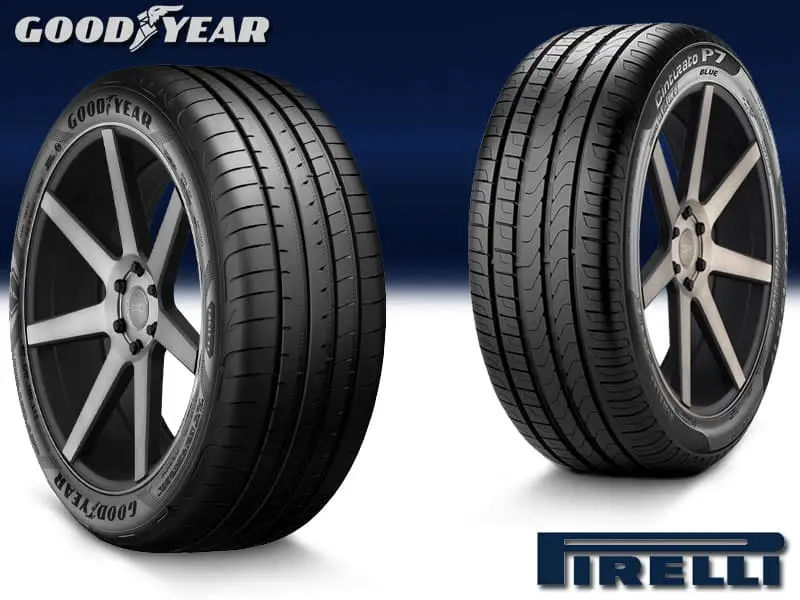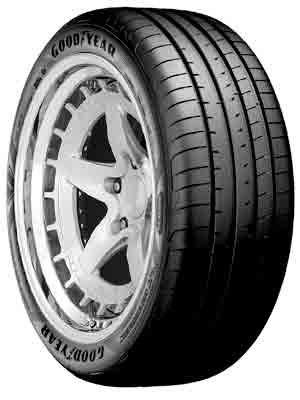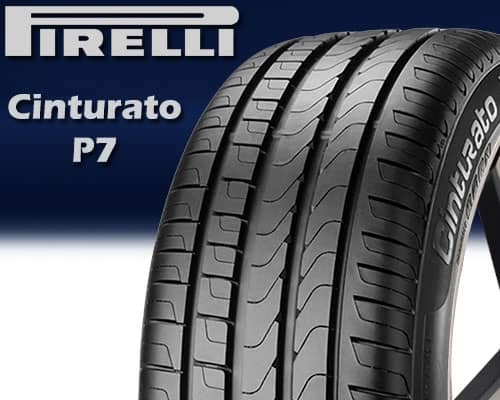Goodyear Eagle F1 Asymmetric 5 vs Pirelli Cinturato P7: Both tires were compared under similar conditions with the same size of 215/50 R18, where both of them have the tread depth of 10/32”. Asymmetric 5 has a higher contact patch, providing extra grip in all conditions whereas the higher void ratio of P7 makes it excel on flooded roads, providing higher hydroplaning resistance.
The bold design and full-depth sipes on the shoulders, bolster the performance of Asymmetric 5 whereas the stronger built and lower rolling resistance, puts P7 ahead in terms of mileage. In this article, you will find how the unique tread design of Asymmetric 5 allows it to perform better in all sorts of conditions.

Examine the treads on these tires closely. They hold the key to knowing which to choose. In fact if you visit my "tread design" page, picking the right tire would never bother you.
Table of Contents
Comparing Asymmetric 5 with Cinturato P7
Goodyear Eagle F1 Asymmetric 5

Pirelli Cinturato P7



Asymmetric 5 has a unique five-pitch tread design, having two ribs and one tread block column between its shoulders. Three circumferential narrow grooves with a decent depth of 10/32” are separating these columns while one groove is a little less wide and features a lower depth. There are no lateral grooves on its shoulders which are replaced by the deep sipes, forming large shoulder blocks. One of the middle columns is separated by shallow sipes while the ribs are only penetrated up till the center. The central rib has inclined sipes covering its one half only whereas the other rib has perpendicular sipes on its outer end which also covers half of its surface.
P7 features an asymmetrical tread design with five tread columns, two of which are shoulder blocks columns. There are no ribs present in this tire, featuring only tread block columns. Four wider circumferential grooves are dividing the tread into five columns. The depth of these grooves is also 10/31”, the same as that of its counterpart. The shoulder blocks are formed by lateral grooves dissecting them. Tie bars are present at the opening of these lateral grooves into the circumferential grooves, blocking the connection between them both. This tire has a different design for both shoulders, one of which has two vertical deep sipes and a few horizontal sipes with a single-step design. While the other shoulder has one perpendicular sipe dividing the shoulder block into two parts and two horizontal straight sipes, continuing from one block to another by passing through the lateral grooves. In the middle section, one of the tread columns has square shape blocks, separated by lateral grooves and having two horizontal and one vertical sipe engraved on them. The other two columns have curved-shaped lateral grooves forming their blocks, with each block having several horizontal and a few vertical straight sipes.
Grip Comparison
The Asymmetric 5 tire has a higher contact patch provided by its two ribs, increasing its grip on-road. A higher grip ensures a lower braking distance along with a better acceleration capability. Thus, it has a better on-road dry grip in comparison. Whereas in wet conditions a higher contact patch and full-depth sipes of this tire allow it to perform well. It has a lower braking distance on the wet surface as well.
P7 due to its lower contact patch secures a lesser grip on the road. It loses the competition due to the absence of ribs, causing the tire to stop after a long distance. While on wet roads, it has numerous sipes but still performs lower due to the absence of higher contact patch and deeper sipes, therefore, it performs lesser in terms of both dry and wet grip.
Handling Comparison
Asymmetric 5 has a higher shoulder block length, allowing greater handling on dry conditions, and its full-length sipes separating the shoulder blocks come in handy while steering on wet roads. It has a lower lap time for both wet and dry tracks.
The lower length of P7’s shoulders blocks put it at a major disadvantage while steering on dry roads. However, its lateral grooves which are dividing its shoulders into separate blocks are helpful while cornering on wet roads but can’t compete with the full depth sipes and higher pitch length of its counterpart. Hence, its lap time is higher for both dry and wet circular tracks, putting it below Asymmetric 5 tire in terms of handling.
Comparison of Hydroplaning Resistance
The narrow grooves don’t allow the asymmetric 5 to effectively wipe away the water, causing this tire to slip, due to the inability of its tread to maintain decent grip, therefore, its hydroplaning resistance is lesser in comparison with the other tire.
The wider grooves of P7 make it superior in extreme wet conditions since its wider and equally deeper grooves can easily pass the water through its tread, reducing the chances of hydroplaning. That’s why this tire is preferred for driving in the rainy season.
Comparison of Rolling Resistance
The higher portion of tread connecting with the ground gives birth to friction between them. For a tire to move forward this friction must be overcome. Asymmetric 5 has a higher contact path, leading to higher friction between its tread and the road, making its rolling resistance higher. Since a lot of force is needed to roll a tire with a higher rolling resistance, hence its fuel consumption is a lot higher than its competitor.
P7 on the other hand, has a lower contact patch, producing lower friction which results in lower rolling resistance. The lower rolling resistance makes this tire fuel-efficient since a lower amount of fuel is required to nullify the friction between the tread and the road.
Comfort and Noise Comparison
The narrow grooves of Asymmetric 5 allow a lesser space for the air particles to get trapped, resulting in a lower noise production by the striking of air particles with the walls of grooves. This makes Asymmetric 5 quieter and with higher performance more comfortable on road. But on bumpy roads, its narrow grooves are unable to dampen the impact of shocks, decreasing its reliability in such conditions.
The wider grooves of P7 are, however, more likely to produce louder noises when moving at a high speed. Because its wider grooves provide more space for the entrapment of air particles, which produce a loud noise by striking grooves walls. Therefore, this tire is uncomfortable on-road due to its lower performance and louder noise. Whereas, it is more efficient in dampening the shock while traveling over an uneven road due to its wider grooves acting as suspension.
Durability and Treadwear Differences
The lower rolling resistance and softer compound used in its tread rubber make Asymmetric 5 a less durable tire, decreasing its treadwear resistance capability. So, it undergoes high wearing because its rolling resistance is also higher. Hence, the tire allows lower mileage comparatively due to its lower durability and higher treadwear.
P7 tire users enjoy the benefits of both higher durability and lower treadwear because its tread is made up of harder rubber compounds, increasing the strength and treadwear resistance of this tire. Along with that, the lower rolling resistance causes lower treadwear, making the tire highly attractive in terms of mileage.
Price Differences
Asymmetric 5 is a higher-priced tire due to its extraordinary performance while P7 focuses on providing higher durability and mileage. There is no comparison between them in terms of performance because Asymmetric exceeds far ahead of its counterpart but if we must think twice before considering this tire due to its both higher price and lower mileage.
Quick Summary
- Both are summer tires.
- The wet and dry traction of Asymmetric 5 is far better than P7.
- P7 exceeds higher than expectations in hydroplaning resistance capability.
- The rolling resistance of P7 is lower.
- Asymmetric produces less sound and is comfortable on-road but can’t provide a smooth ride on bumpy roads.
- P7 is a higher-durable tire with better mileage.
- Asymmetric 5 is a higher-priced tire.



